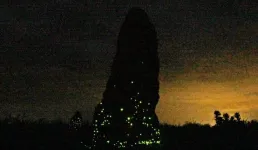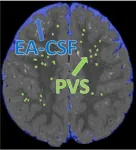(Press-News.org) At night in the Cerrado, Brazil’s savanna and second-largest biome, larvae of the click beetle Pyrearinus termitilluminans, which live in termite mounds, display green lanterns to capture prey attracted by the bright light.
In more than 30 years of expeditions with his students to Emas National Park and farms around the conservation unit in Goiás state to collect specimens, the phenomenon has never been so rare, said Vadim Viviani, a professor at the Federal University of São Carlos’s Science and Technology for Sustainability Center (CCTS-UFSCar) in Sorocaba, São Paulo state.
“In the 1990s, we would see many of these termite mounds full of fireflies and other bioluminescent insects, even in areas of pasture. Now, sugarcane is grown in most of the areas and we hardly see any,” he noted.
The dearth was one of the main findings of a study supported by FAPESP via its Research Program on Biodiversity Characterization, Conservation, Restoration and Sustainable Use (BIOTA-FAPESP), as reported in an article by Viviani and collaborators published in Annals of the Entomological Society of America.
The penultimate author of the article, Etelvino Bechara, a professor at the University of São Paulo’s Institute of Chemistry (IQ-USP), was Viviani’s master’s and PhD thesis advisor in the 1990s and is also supported by FAPESP.
The other co-authors are Cleide Costa, a researcher at the University of São Paulo’s Museum of Zoology (MZ-USP), and Simone P. Rosa, an entomologist at the Federal University of Itajubá (UNIFEI) in Minas Gerais state. Both are authorities on the taxonomy of the click beetle superfamily Elateroidea.
The survey recorded 51 species, most of which are fireflies (Lampyridae). The rest are click beetles (Elateridae), which have two lanterns on their back, and railroad worms, also known as glow worms (Phengodidae), which can produce light of different colors at the same time.
In Goiás, besides the specimens collected in Emas National Park in the municipality of Mineiros, and nearby farms, the researchers cataloged specimens in Perolândia and Campinorte. In Mato Grosso state, the survey covered Chapada dos Guimarães National Park and three towns (Alto Garças, Novo Santo Antônio and Rio Manso). In Costa Rica, a town in Mato Grosso do Sul state, they visited two farms and Sucuriú Falls Municipal Park. Emas National Park was the most productive site, providing 35 species.
The researchers say the diversity of these beetles in remnants of the Cerrado and farms neighboring the park has declined sharply over the last three decades, concurrently with the substitution of soybean and sugarcane plantations for pasture, as well as a reduction in the Cerrado overall, and more specifically in dense dry forest areas within the Cerrado known as cerradão.
The occurrence of luminous termite mounds in Chapada dos Guimarães National Park is reported for the first time in this article. Many mounds full of firefly larvae are found in Emas National Park and neighboring areas. Previous research by the same group reported the phenomenon of bioluminescence in the Amazon Rainforest (read more at: agencia.fapesp.br/23640).
Railroad worms are disappearing
Pesticides and artificial lighting are also enemies of bioluminescent beetles. Bright light produced by humans prevents them from being located by mates and reproducing. In particular, the researchers noted the absence of railroad worm larvae in recent expeditions. These insects can emit red and green light at the same time and have significant biotechnological potential (read more at: agencia.fapesp.br/31481).
“The decline in this family [Phengodidae] was especially evident. Adult males are no longer attracted to light traps on farms surrounded by sugarcane since 2010. Furthermore, the increasing levels of artificial light coming from nearby urban centers at night may threaten several bioluminescent species inside Emas National Park. The problem merits special attention and further studies,” Viviani said.
Extinction of bioluminescent species is not only a loss to biodiversity and the ecosystem services provided by these animals but also represents lost technological and economic opportunities.
Bioluminescence – production and emission of cold visible light by living beings – is useful to many analytical processes deployed in scientific research, medicine, industry and environmental management. Cold light means less than 20% of the light generates thermal radiation (i.e. heat).
Bioluminescence derives from oxidation of luciferin, a compound present in these insects and other animals as well as some fungi. The oxidation process is catalyzed by enzymes known as luciferases.
Over the years, the group led by Viviani has isolated and cloned the largest number of luciferases of any group globally. The luciferases are from different insects, including flies that produce blue light (read more at: agencia.fapesp.br/34061 and agencia.fapesp.br/29066).
Luminescent beetles produce colors such as green, yellow, orange and red. Their luciferases are used to mark cells and proteins, for example (read more at: agencia.fapesp.br/36427 and agencia.fapesp.br/20609).
Viviani is currently coordinating a project supported by FAPESP to develop bioluminescent reagents for immunoassays, environmental analysis and bioimaging. The reagents will be based on luciferases from Brazilian species. Most of these materials are currently imported.
“It’s important to grasp the fact that the Cerrado isn’t just scrub or bush. It’s a repository of water in the soil, a source of evaporation that generates rain, and also an immense store of exclusive species. We can learn a tremendous amount from all that treasure,” Viviani said.
About São Paulo Research Foundation (FAPESP)
The São Paulo Research Foundation (FAPESP) is a public institution with the mission of supporting scientific research in all fields of knowledge by awarding scholarships, fellowships and grants to investigators linked with higher education and research institutions in the State of São Paulo, Brazil. FAPESP is aware that the very best research can only be done by working with the best researchers internationally. Therefore, it has established partnerships with funding agencies, higher education, private companies, and research organizations in other countries known for the quality of their research and has been encouraging scientists funded by its grants to further develop their international collaboration. You can learn more about FAPESP at www.fapesp.br/en and visit FAPESP news agency at www.agencia.fapesp.br/en to keep updated with the latest scientific breakthroughs FAPESP helps achieve through its many programs, awards and research centers. You may also subscribe to FAPESP news agency at http://agencia.fapesp.br/subscribe.
END
Diversity of bioluminescent beetles in Brazilian savanna has declined sharply in 30 years
Surveys conducted in the Cerrado since the 1990s show falling biodiversity as the agricultural frontier advances in the vicinity of Emas National Park. Species with biotechnological potential are dwindling and even disappearing
2024-01-02
ELSE PRESS RELEASES FROM THIS DATE:
Binghamton University professor and Nobel Laureate Stanley Whittingham wins 2023 VinFuture Grand Prize
2024-01-02
Binghamton University, State University of New York Distinguished Professor and Nobel Laureate M. Stanley Whittingham has been chosen as the joint winner of the $3 million 2023 VinFuture Grand Prize in recognition of his contributions to the invention of lithium-ion batteries. The prize recognized how the combination of solar energy and lithium battery storage is overcoming climate change and was recently presented by the Prime Minister of Vietnam.
“I am truly honored to be chosen for this prestigious honor,” said Whittingham. “VinFuture’s efforts to recognize green and sustainable energy is a noble cause, and ...
Deciphering molecular mysteries: new insights into metabolites that control aging and disease
2024-01-02
ITHACA, NY: In a significant advancement in the field of biochemistry, scientists at the Boyce Thompson Institute (BTI) and Cornell University have uncovered new insights into a family of metabolites, acylspermidines, that could change how we understand aging and fight diseases.
The study, recently published in Nature Chemical Biology, presents an unexpected connection between spermidine, a long-known compound present in all living cells, and sirtuins, an enzyme family that regulates many life-essential functions.
Sirtuins ...
Women’s and girls’ sports: more popular than you may think
2024-01-02
COLUMBUS, Ohio – The number of Americans who watch or follow girls’ and women’s sports goes well beyond those who view TV coverage of women’s athletic events, a new study suggests.
In fact, just over half of American adults spent some time watching or following female sports in the past year, the results showed.
U.S. adults spend about one hour a week consuming female sports content, which may seem higher than expected, according to the researchers. Still, it is only a small fraction of Americans’ overall sports consumption.
The study was ...
Calcium channel blockers key to reversing myotonic dystrophy muscle weakness, study finds
2024-01-02
New research has identified the specific biological mechanism behind the muscle dysfunction found in myotonic dystrophy type 1 (DM1) and further shows that calcium channel blockers can reverse these symptoms in animal models of the disease. The researchers believe this class of drugs, widely used to treat a number of cardiovascular diseases, hold promise as a future treatment for DM1.
“The main finding of our study is that combined calcium and chloride channelopathy is highly deleterious and plays a central role in the function impairment of muscle found in the disease,” said John Lueck, Ph.D., an assistant professor at the University of Rochester Medical Center (URMC) in the Departments ...
Enlarged spaces in infant brains linked to higher risk of autism, sleep problems
2024-01-02
Throughout the day and night, cerebrospinal fluid (CSF) pulses through small fluid-filled channels surrounding blood vessels in the brain, called perivascular spaces, to flush out neuroinflammation and other neurological waste. A disruption to this vital process can lead to neurological dysfunction, cognitive decline, or developmental delays.
For the first time, researchers Dea Garic, PhD, and Mark Shen, PhD, both at the UNC School of Medicine’s Department of Psychiatry, discovered that infants with abnormally enlarged perivascular spaces have a 2.2 times greater chance of developing autism ...
Growth hormone influences regulation of anxiety via a specific group of neurons
2024-01-02
Growth hormone (GH) acts on many tissues throughout the body, helping build bones and muscles, among other functions. It is also a powerful anxiolytic. A study conducted by researchers at the University of São Paulo (USP) in Brazil has produced a deeper understanding of the role of GH in mitigating anxiety and, for the first time, identified the population of neurons responsible for modulating the influence of GH on the development of neuropsychiatric disorders involving anxiety, depression and post-traumatic stress. An article on the study is published in the Journal of Neuroscience.
In ...
Influencers’ vulnerabilities: a double-edged sword
2024-01-02
ITHACA, N.Y. – New Cornell University-led research finds that social media platforms and the metrics that reward content creators for revealing their innermost selves to fans open creators up to identity-based harassment.
“Creators share deeply personal – often vulnerable – elements of their lives with followers and the wider public,” said Brooke Erin Duffy, associate professor of communication. “Such disclosures are a key way that influencers build intimacy with audiences and form communities. There’s a pervasive sense that internet users clamor for less polished, less idealized, ...
Designing the ‘perfect’ meal to feed long-term space travelers
2024-01-02
Imagine blasting off on a multiyear voyage to Mars, fueled by a diet of bland, prepackaged meals. As space agencies plan for longer missions, they’re grappling with the challenge of how to best feed people. Now, researchers reporting in ACS Food Science & Technology have designed the optimal “space meal”: a tasty vegetarian salad. They chose fresh ingredients that meet male astronauts’ specialized nutritional needs and can be grown in space.
Astronauts in space burn ...
Perceived time has an actual effect on physical healing
2024-01-02
Perceived time has a significant impact on the actual time it takes to heal physical wounds, according to new research by Harvard psychologists Peter Aungle and Ellen Langer.
Their study, published late last month in Nature Scientific Reports, challenges conventional beliefs about psychological influences on physical health. The findings suggest a broader range of psychological influences than is currently appreciated.
To complete their study, the authors used a standardized procedure to mildly wound volunteer subjects. Perceived time was then manipulated in the lab, with each study participant completing three ...
Use of cryopreserved oocytes in patients with poor ovarian response
2024-01-02
About The Study: This study of 67,000 freezing cycles among 47,000 patients reveals a distinct pattern in the utilization of cryopreserved oocytes among patients undergoing planned oocyte cryopreservation in the U.S. Despite the increase in number of patients pursuing oocyte cryopreservation, there is a notably low rate of return to utilize previously vitrified oocytes; notably, patients with poor ovarian response are more likely to return, although the time to return is similar to those with normal ovarian response.
Authors: Yuval Fouks, M.D., M.P.H., of Boston IVF-The Eugin Group in Waltham, Massachusetts, is the corresponding ...
LAST 30 PRESS RELEASES:
The perfect plastic? Plant-based, fully saltwater degradable, zero microplastics
Bias in data may be blocking AI’s potential to combat antibiotic resistance
Article-level metrics would provide more recognition to most researchers than journal-level metrics
Satiety’s little helper: Protein that supports appetite regulating protein identified
UF dives deep into predicting storm damage with computer models
A stormy ocean voyage yields insights on the global carbon cycle
Scientists identify first non-coding gene that controls cell size
Demonstration of altermagnetism in RuO₂ thin films -- A new magnetic material for the AI era
Penn researchers awarded $25M to conduct trial using smartphones to fight heart disease
PCORI awards funding for new patient-centered healthcare research
Exploring the origins of the universe: 145 low-noise amplifiers complete ALMA telescopes
Empress cicada wings help illuminate molecular structure
Using sound waves to detect helium
Time burden in patients with metastatic breast and ovarian cancer from clinic and home demands
Researchers discover bias in AI models that analyze pathology samples
Scientists ID potential way to prevent brain injuries from triggering Alzheimer's
MASTER 2nd Open Call: Execution period kick-off
Algae for health in food and pharma
Advanced microrobots driven by acoustic and magnetic fields for biomedical applications
Chicago health information leader recognized for raising CPR readiness and blood pressure awareness
The Intimate Animal, a new book from Kinsey Institute Executive Director Dr. Justin Garcia
When blue-collar workers lose union protection, they try self-employment
New video dataset to advance AI for health care
MEA-based graph deviation network for early autism syndrome signatures in human forebrain organoids
New modeling approach sheds light on rare gut disease
Study documents potentially hazardous flame retardants in firefighter gear
Can certain bacteria regulate aging of the immune system and its related alterations?
AI model helps diagnose often undetected heart disease from simple EKG
There are fewer online trolls than people think
Cell membrane fluctuations produce electricity
[Press-News.org] Diversity of bioluminescent beetles in Brazilian savanna has declined sharply in 30 yearsSurveys conducted in the Cerrado since the 1990s show falling biodiversity as the agricultural frontier advances in the vicinity of Emas National Park. Species with biotechnological potential are dwindling and even disappearing



